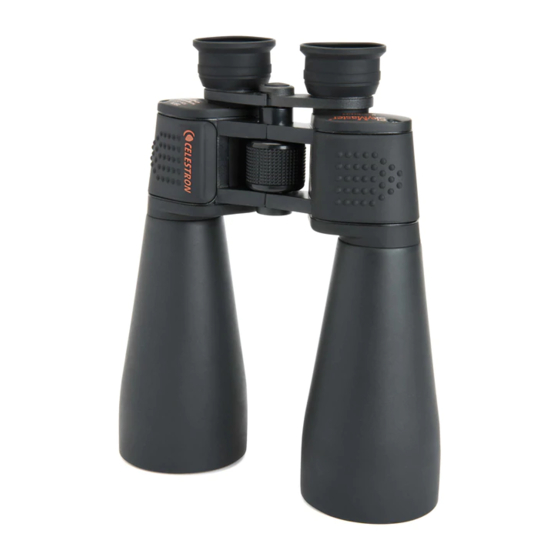
Advertisement
Quick Links
Sky Master 15X70 Binocular and
Tripod/Mount
USER GUIDE
WARNING: Never look directly at the Sun through
binoculars— even for an instant — as permanent
eye damage will result. Do not point the
binoculars at the Sun, as parts will melt! Children
should use this telescope only with adult
supervision.
The Telescope Lending Program is brought
to you by:
About the SVO Telescope Lending Progra
1
Advertisement

Summary of Contents for stellar labs Sky Master
- Page 1 Sky Master 15X70 Binocular and Tripod/Mount USER GUIDE WARNING: Never look directly at the Sun through binoculars— even for an instant — as permanent eye damage will result. Do not point the binoculars at the Sun, as parts will melt! Children should use this telescope only with adult supervision.
- Page 2 Discover the Night Sky Stellar Vista Observatory (SVO), a 501c3 nonprofit based in Kanab, UT, received a grant from the Utah Governor's Office of Outdoor Recreation with matching funds from the Kane County Office of Tourism to launch its Discover the Night Sky program.
-
Page 3: Table Of Contents
Note: Adult supervision is recommended for all equipment setup We suggest reading this user guide and practicing with the binoculars inside before you take it out in the dark. Table of Contents: Adjusting binoculars ………………………. Setting up tripod & mount ………………… Attaching binoculars …………………….. -
Page 4: Adjusting Binoculars
Adjusting Binoculars: Adjusting the Interpupillary Distance (IPD) Since the distance between the eyes varies among individuals, the two eyepieces of the binoculars must be correctly aligned (adjusted). This is called adjusting the interpupillary distance. To adjust this distance, lift the binoculars up to your eyes (using both hands) and look through them at an object in the distance. -
Page 6: Setting Up Tripod & Mount
Note: The tripod provides a stable platform necessary for night sky viewing with the powerful binoculars provided. Setting up the Tripod Spread the legs of the tripod as far as they will go and lock them in place by tightening the brace lock knob. - Page 8 Attaching the Paragon-Plus Binocular Mount to the Tripod Line up the threaded pan head attachment shaft of the tripod with the threaded hole on the bottom of the pivot disk. Then hold the binocular mount still while turning the pivot disk to thread it onto the shaft.
-
Page 9: Attaching Binoculars
Attaching the Binocular to the Binocular Mount Adjust the tripod height to the level you will be viewing from before mounting the binoculars. Thread the binocular mounting knob into the tripod adapter on the binocular until it is secure. -
Page 10: Balancing Binocular Mount
Balancing the Paragon-Plus Binocular Mount To assure smooth movement, the binocular should be properly balanced on the mount by adjusting the counterweight shaft. Loosen all four tension knobs and carefully bring the mount to a horizontal position. Loosen the counterweight shaft knobs and slide the counterweight shaft out from the mount until it balances the binocular on the other end. -
Page 11: Adjusting Binocular On Tripod
Adjusting the “Tilt Angle” of the Binocular: You should set the knob tension such that the binocular will move when pushed, but will not move on its own. Keep in mind that as the angle of the binocular approaches vertical, the knob tension will need to be increased so that the binocular does not flop over. - Page 12 Moving the binocular in Adjusting Azimuth: azimuth (left/right) is a simple matter of turning the mount on its pivot disk. There is no azimuth lock feature. A nice Adjusting the Height of the Binocular: feature of the Paragon-Plus binocular mount is that when the binocular is pointed at an object, the height can be adjusted for different viewers without moving the binocular off its target.
-
Page 13: Transporting
The parallelogram Parallelogram Safety Stop: has a safety stop to prevent the aluminum bars from completely collapsing. This ensures that no fingers will be caught and crushed by an accidental fast closing of the parallelogram. This feature will also prevent the counterweight from hitting the tripod. -
Page 14: Observation Guide
When and where to observe: Before you head out in the dark be sure to have everything you will need. #Plan for what to observe #Know where objects are in the sky #Tripod and Mount #Black accessory bag and binocular #Table #Be sure weather conditions are suitable Note: Please do not use SVO equipment in rain,... - Page 15 Our FAQs provide daily astronomical weather forecasts. www.stellarvistaobservatory.org/discover-the-night- sky/#faq Where: Southern Utah is famous for its dark night skies. But, if your home is surrounded by bright lights, you might need to drive a little bit to find them. For example, Dark skies are not required if you just want to look at the moon or planets, but important for most other celestial objects.
-
Page 16: Support
One more time: WARNING: Never look directly at the Sun through binoculars— even for an instant — as permanent eye damage will result. Do not point the binoculars at the Sun, as parts will melt! Children should use this telescope only with adult supervision.
Need help?
Do you have a question about the Sky Master and is the answer not in the manual?
Questions and answers